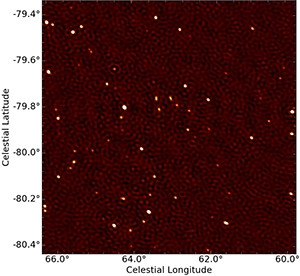
Using only four of the eventual 64 dishes, an observation at the MeerKAT radio telescope this month produced a remarkable view of the sky, revealing never seen before radio galaxies in the distant universe.
Of late, SA has had an upper hand in astronomy. This month, the Southern African Large Telescope helped detect the first white dwarf pulsar, the latest co-discovery that has astronomers eager to use the largest optical telescope in the southern hemisphere to unlock the galaxy's secrets.
Last month, South African astronomers scored another first when they caught a glimpse of the early universe by chance.
Powerful instrument
MeerKAT, a project of Square Kilometre Array SA (SKA SA), which is overseen by the Department of Science and Technology (DST), will be made up of 64 dishes spread over a diameter of 8km in the Northern Cape.
When completed by late next year, it will be one of the world's most powerful scientific instruments. Eventually, MeerKAT will be integrated into the even more powerful SKA telescope.
Using the four dishes, scientists observed more than 50 radio sources (white dots) in a one square degree panorama (corresponding to five times the area of the Moon).The scientists say unlike an ordinary picture of the sky that mainly shows stars in our own Milky Way Galaxy, these dots arise from galaxies in the distant universe emitting radio waves at a frequency of 1 400MHz, which is 15 times the frequency of FM radio stations.
They also observed yellow ellipses, indicating radio sources detected in a similar observation done with KAT-7 (a seven-dish precursor to MeerKAT, also located in the Karoo), and green ellipses showing radio sources detected in Australia's survey of the southern sky.
Some of the yellow ellipses are resolved into two green counterparts, showing the four-dish test observation produces sharper images than possible with KAT-7. Some of the white dots do not have a green or yellow counterpart, indicating this commissioning image obtained with four MeerKAT dishes has already detected previously unknown radio galaxies, the scientists explain.
However, they point out these are not first light images of MeerKAT but rather test images.
"This wonderful result has enormous significance," says professor Justin Jonas, associate director for science and engineering, SKA SA.
Confidence boost
Following the findings on 14 May, more than 100 researchers and students from SA and around the world are meeting this week to share plans to use the MeerKAT radio telescope. As the conference takes place in Stellenbosch, construction of the telescope continues apace in the Karoo, while commissioning scientists and engineers at the SKA SA office in Cape Town run tests with the first elements of the dish array.
"Just 10 years ago, I would not have imagined that we would be hosting such a prestigious meeting in South Africa and building a world-leading radio telescope. This image and all that lies behind it adds to our confidence that this very complex project will be the success that we have been planning for over the past decade," Jonas notes.
"This image covers less than 0.01% of the entire celestial sphere," explains Dr Fernando Camilo, SKA SA chief scientist. "Given that we detect more than 50 galaxies in such a small patch of sky, observed with only four dishes, imagine the discoveries that are going to be made surveying the entire South African sky with the full 64-dish MeerKAT."
The MeerKAT science programme will consist of legacy-style, large survey projects, plus open time available for new proposals. Legacy-style science will include the Laduma and pulsar Timing programmes.
Laduma (Looking at the Distant Universe with the MeerKAT Array) is an ultra-deep survey of neutral hydrogen gas in the distant universe. One of the aims of the Pulsar Timing programme is to help detect gravitational waves from a collection of coalescing super-massive black holes at the centres of distant galaxies.
Share